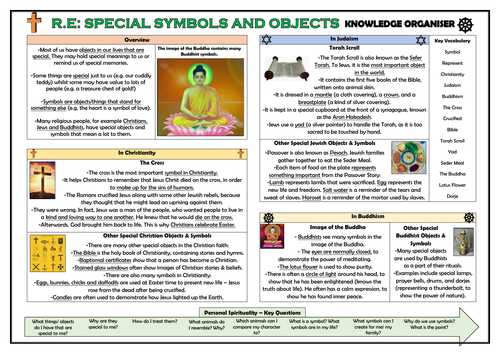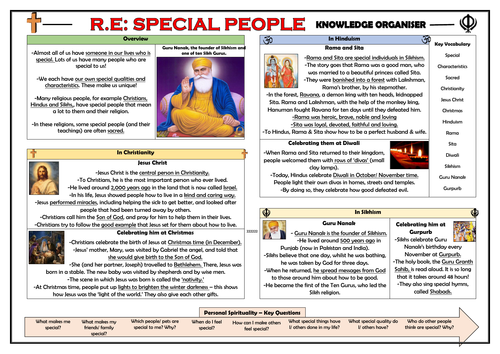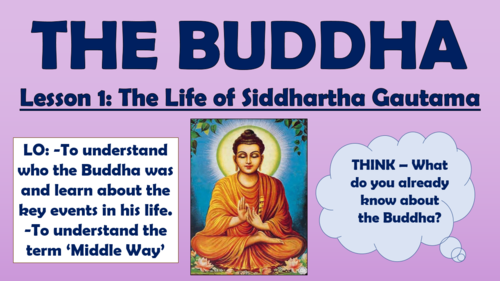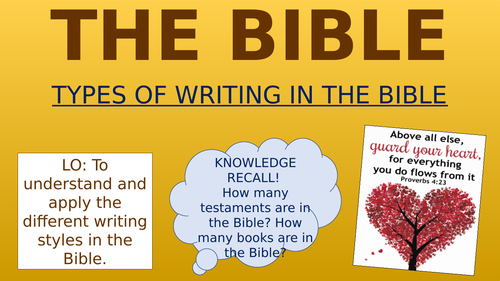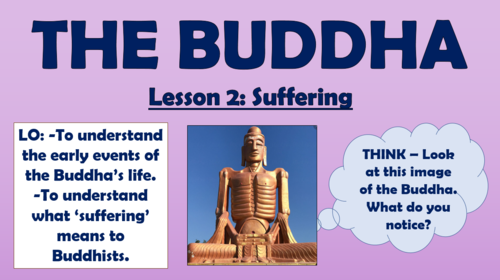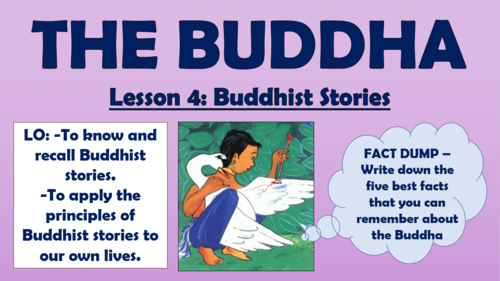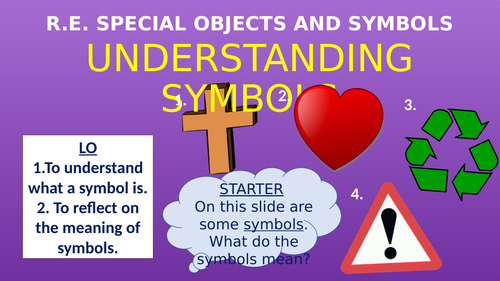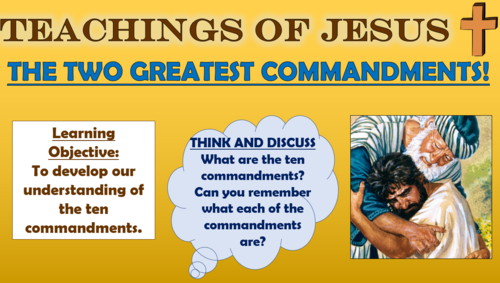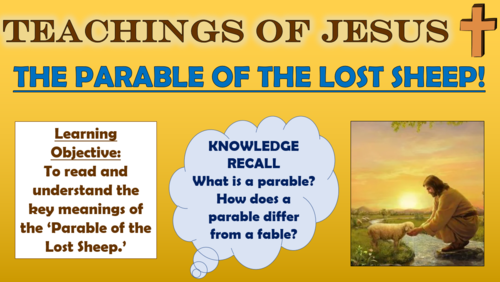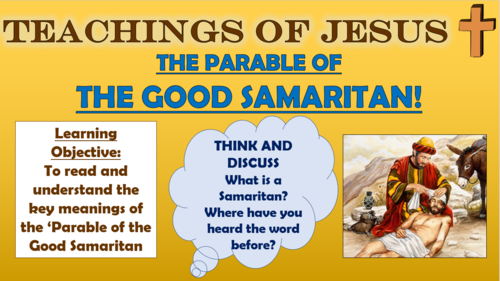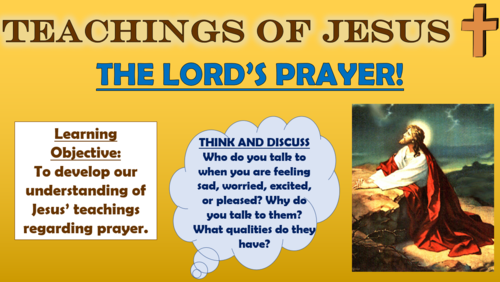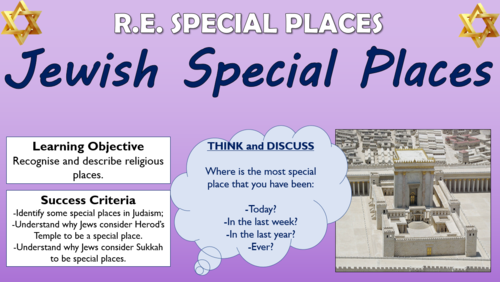
3k+Uploads
1904k+Views
2237k+Downloads
Religious education

Special Words and Stories - RE Knowledge Organiser!
This clear, detailed and visually-appealing resource offers a complete reference point for children learning or revising knowledge of ‘special words and stories’ in RE. It contains comprehensive sections on:
-Overview - How books, stories and words can be special;
-In Christianity - The Bible, The Lord’s Prayer and the Easter Story;
-In Judaism - The Megillat Esther and The Torah;
-In Sikhism - The Guru Granth Sahib
-Personal Spirituality - Key Questions
-Key Vocabulary.
The resource is designed to be printed onto A3, and is provided as both a PDF and a Word version (so that you can edit if you want to). All images used are licensed for commercial use and are cited on a separate document (included). It is most appropriate for KS1 and lower KS2 children.

RE - Special Symbols and Objects Knowledge Organiser!
This clear, detailed and visually-appealing resource offers a complete reference point for children learning or revising knowledge of ‘special symbols and objects’ in RE. It contains comprehensive sections on:
-Overview - What are special objects and symbols?
-In Christianity - The Cross & Other Special Christian Objects and Symbols;
-In Judaism - The Torah Scroll & Other Special Jewish Objects and Symbols;
-In Buddhism - The Image of the Buddha & Other Special Buddhist Objects and Symbols;
-Personal Spirituality - Key Questions;
-Key Vocabulary.
The resource is designed to be printed onto A3, and is provided as both a PDF and a Word version (so that you can edit if you want to). All images used are licensed for commercial use and are cited on a separate document (included). It is most appropriate for KS1 and lower KS2 children.

RE - Special People Knowledge Organiser!
This clear, detailed and visually-appealing resource offers a complete reference point for children learning or revising knowledge of ‘special people’ in RE. It contains comprehensive sections on:
-Overview - How are people special?
-In Christianity - Jesus Christ (and how he is celebrated at Christmas);
-In Hinduism - Rama and Sita (and how they are celebrated at Diwali);
-In Sikhism - Guru Nanak (and how he is celebrated at Gurpurb);
-Personal Spirituality - Key Questions;
-Key Vocabulary.
The resource is designed to be printed onto A3, and is provided as both a PDF and a Word version (so that you can edit if you want to). All images used are licensed for commercial use and are cited on a separate document (included). It is most appropriate for KS1 and lower KS2 children.

The Buddha - The Life of Siddhartha Gautama!
In this engaging lesson, students are introduced to who Siddhartha Gautama was, and learn how he became the Buddha. They also begin to discuss the ‘Middle Way’, and consider how these ideas can be applied to modern life.
The learning is guided by a clear and colourful PowerPoint presentation, which guides students through the following step-by-step journey:
-Knowledge harvesting - gauging what children already know about the Buddha;
-Watching a short video (hyperlinked) about the life of Siddhartha Gautama;
-Explaining the key events in his life, using a storyboard template;
-Discussing what is meant by the ‘Middle Way’, and how this helped Gautama to find enlightenment;
-Thinking about how they can apply the ideas of the ‘Middle Way’ to their own lives;
-Considering a deeper thinking extension question;
-Completing a plenary to assess their understanding.
This resource pack contains a comprehensive Powerpoint, alongside an eye-catching worksheet.
In the past, I have used this lesson with children from across Key Stage 2 - the key learning is aligned with curriculum expectations for RE, and also the content prescribed by most diocese regions. All images are licensed for commercial use.

The Bible - Types of Writing in the Bible!
In this engaging and informative lesson, students learn about the different types of writing in the Bible, consider how these different writing forms get across key messages, and apply this knowledge in creating their own thoughtful texts. They learn through:
-Recalling and remembering how to reference different sections of the Bible;
-Acting as ‘Bible Detectives’, follwing references in order to find different styles of writing;
-Analysing how different styles of writing add to meanings/ messages;
-Considering important messages and lessons that they have been given in their own lives, and applying knowledge of different writing styles to contribute to a ‘Class Bible’;
-Evaluating their ‘Class Bible’ through thought-provoking reflection questions;
This resource pack contains a comprehensive and colourful 17-slide Powerpoint, which guides teachers and students through the learning activities. Challenge activities are provided in order to enrich learning for higher-attaining learners.
A part of the lesson includes using Bibles, so you will need enough for at least one per group in your class.
In the past, I have used this lesson with children from across Key Stage 2 - the key learning is aligned with national expectations for RE, and also the content prescribed by most diocese regions. All images are licensed for commercial use, and are cited on the final slide.

Churches - The Features of Churches!
In this lesson, students learn about the key features of Anglican churches.
Some of the features covered include: the font, the altar, the pulpit, the lecturn, the nave, the crucifix and stained glass windows. Students learn about the key purpose of the features, and where they can be found in the church.
Students also begin to comprehend what the features symbolise.
This resource pack contains a comprehensive 16-slide Powerpoint, alongside an eye-catching worksheet. Two extension activities are provided in order to challenge higher ability learners.
In the past, I have used this lesson with children from across Key Stage 2 - the key learning is aligned with NC expectations for RE, and also the content prescribed by most diocese regions. All images are licensed for commercial use, and are cited on the final slide.

KS1 RE - My Special Places!
In this engaging lesson, students consider the places that are important to them. The lesson serves as a foundation for children’s later learning about places that are special to people of different faiths.
The learning is guided by a clear and colourful PowerPoint presentation, which guides students through the following step-by-step journey:
-Discussing the differences between a house and a home;
-Considering what features make a home a special place to many people;
-Identifying the things that make their own homes a special place;
-Brainstorming other places that people may consider as special, e.g. their town or their school;
-Understanding that different people are individuals, and have their own opinions of places that are special;
-Completing a plenary activity to assess their understanding;
-Self-reflecting on the extent to which they feel they have met the learning objective.
This resource pack includes the comprehensive PowerPoint presentation (17 slides) and the template for the main special places activity (provided in Word and PDF). There is everything that you need here to teach the lesson.
In the past, I have used this lesson with children from across Key Stage 1 - the key learning is aligned with curriculum expectations for RE, and also the content prescribed by most diocese regions. All images are licensed for commercial use.

The Bible - Interpretations of the Bible!
In this engaging and informative lesson, students learn how Christians may interpret the Bible differently. They learn about the meaning of ‘liberal’ and ‘fundamentalist’ Christians, and understand how these two viewpoints influence interpretations of different Bible stories. They learn through:
-Recalling and remembering foundation contextual facts about the Bible;
-Defining the word ‘interpretation’ and understanding that people can interpret the same things differently;
-Learning about the differences in beliefs between fundamentalist Christians and liberal Christians;
-Watching the story of Jesus’ baptism (link included) and establishing how fundamentalist and liberal Christians may interpret different sections of the story;
-Considering how their work on different interpretations may influence the way that they see and behave towards other people with different ideas to themselves.
This resource pack contains a comprehensive and colourful 15-slide Powerpoint, which guides teachers and students through the learning activities. Challenge activities are provided in order to enrich learning for higher-attaining learners. A link to the video is also included (slide 9).
In the past, I have used this lesson with children from across Key Stage 2 - the key learning is aligned with national expectations for RE, and also the content prescribed by most diocese regions.
The resource is also suitable for home learning
All images are licensed for commercial use, and are cited on the final slide.

The Buddha - Suffering!
In this engaging lesson, students gain a deeper understanding of the early part of the Buddha’s life. They also consider the idea of suffering, and contemplate how Siddhartha Gautama aimed to find an end to suffering.
The learning is guided by a clear and colourful PowerPoint presentation, which guides students through the following step-by-step journey:
-Inferring - looking at a picture of the Buddha and reading between the lines to understand what it shows us;
-Considering the concept of suffering by answering key questions;
-Reading and discussing the key events of Siddhartha Gautama’s early life;
-Writing two diary entries from the perspective of Siddhartha Gautama - before and after he witnesses suffering - using a helpful diary success criteria sheet;
-Thinking about how they can apply the idea of the suffering to their own lives;
-Considering a deeper thinking extension question;
-Completing a plenary to assess their understanding.
This resource pack contains a comprehensive Powerpoint, alongside an eye-catching worksheet.
In the past, I have used this lesson with children from across Key Stage 2 - the key learning is aligned with curriculum expectations for RE, and also the content prescribed by most diocese regions. All images are licensed for commercial use.

The Buddha - Buddhist Stories!
In this engaging lesson, students gain a deeper understanding of Buddhist stories that influence the ways in which Buddhists treat animals.
The learning is guided by a clear and colourful PowerPoint presentation, which guides students through the following step-by-step journey:
-Watching video clips telling the story of Siddhartha and the Swan and The Monkey King (link provided);
-Answering comprehension questions to demonstrate understanding of the stories;
-Understanding the key messages that these stories give Buddhists to take on in their lives;
-Thinking about how they can apply these principles to their own lives;
-Creating a poster for Buddhists about treatment of animals, using their learning from across the lesson;
-Completing a plenary to assess their understanding.
In the past, I have used this lesson with children from lower Key Stage 2 - the key learning is aligned with curriculum expectations for RE, and also the content prescribed by most diocese regions. All images are licensed for commercial use.

KS1 RE - Special Places - Mosques!
In this engaging lesson, students develop their understanding of churches and what happens in them. It was originally taught as a part of an RE unit on ‘Special Places.’
The learning is guided by a clear and colourful PowerPoint presentation, which guides students through the following step-by-step journey:
-Knowledge harvesting what children already know about mosques, and what they would like to find out;
-Learning the basics about Mosques, before reading and comprehending ‘An Important Job for Qaswa the Camel’ - an age-appropriate story about the first mosque;
-Studying a number of images of different features in mosques and discussing why each feature is important;
-Understanding what makes mosques special places to Muslims, and finding similarities and differences between mosques and churches;
-Completing a plenary activity to assess their understanding;
-Self-reflecting on the extent to which they feel they have met the learning objective.
This resource pack includes the comprehensive PowerPoint presentation (24 slides) and the story for the comprehension activity (provided in Word and PDF). There is everything that you need here to teach the lesson.
In the past, I have used this lesson with children from across Key Stage 1 - the key learning is aligned with curriculum expectations for RE, and also the content prescribed by most diocese regions. All images are licensed for commercial use.

RE - Special Things in Nature Knowledge Organiser!
This clear, detailed and visually-appealing resource offers a complete reference point for children learning or revising knowledge of ‘special things in nature’ in RE. It contains comprehensive sections on:
-Overview - How and why is nature special?
-In Christianity - The Christian Creation Story/ Saint Francis of Assisi;
-In Islam - The Cave on Mount Hira/ Care of Animals;
-In Hinduism - Gods of Nature/ The Hindu Creation Story;
-Personal Spirituality - Key Questions;
-Key Vocabulary.
The resource is designed to be printed onto A3, and is provided as both a PDF and a Word version (so that you can edit if you want to). All images used are licensed for commercial use and are cited on a separate document (included). It is most appropriate for KS1 and lower KS2 children.

Understanding Symbols - KS1 RE Lesson!
In this engaging and informative lesson, children learn what symbols are, and begin to interpret and reflect on the meaning of symbols. They apply this knowledge in creating their own symbols, considering what the objects/ animals, colours and shapes that they select represent.
I used this as an introductory lesson, before then going into more depth about different religious symbols in the subsequent lessons. Children enjoyed it and it gave them a solid understanding of symbols to build on in the next steps of their learning.
This resource pack contains a comprehensive and colourful 15-slide Powerpoint, which guides teachers and students through the learning activities. A template worksheet is also provided (in Word and PDF) for the students to create and describe their symbol.
In the past, I have used this lesson with children in both Years 1 and 2 - the key learning is aligned with national expectations for RE, and also the content prescribed by most diocese regions. All images are licensed for commercial use, and are cited on the final slide.

Teachings of Jesus - The Two Greatest Commandments!
In this engaging lesson, students develop their understanding of the ten commandments. They particularly consider what Jesus communicated as ‘the two greatest commandments’ (‘Love God’ and ‘Love thy Neighbour’).
The learning is guided by a clear and colourful PowerPoint presentation, which guides students through the following step-by-step journey:
-Recalling each of the ten commandments and translating them into modern English;
-Knowledge recall - remembering key facts about Jesus’ life and teaching;
-Ranking the commandments in order of those that they feel are most important;
-Reading and discussing Jesus’ lesson on the most important commandments;
-Considering the messages that they can take for their own lives from this message;
-Creating 10 commandments for the modern world;
-Self-reflecting on the extent to which they feel they have met the learning objective.
The resource pack includes everything you need to teach the lesson, including the comprehensive PowerPoint presentation and the Bloom’s Taxonomy worksheet (provided in both Word and as a PDF). Just download and teach!
In the past, I have used this lesson with children from across Key Stage 2 with minor adaptations for age - the key learning is aligned with curriculum expectations for RE, and also the content prescribed by most diocese regions. All images are licensed for commercial use.

Teachings of Jesus - The Parable of the Lost Sheep!
In this engaging lesson, students read and interpret ‘The Parable of the Lost Sheep.’
The learning is guided by a clear and colourful PowerPoint presentation, which guides students through the following step-by-step journey:
-Knowledge recall - remembering key facts about Jesus’ life and teaching;
-Discussing why Jesus’ parables continue to give important messages;
-Watching an engaging, age-appropriate video of the parable;
-Interpreting the parable through comprehension questions, and deciphering its key meanings;
-Using the storyboard template provided to demonstrate their understanding of the parable and its morals;
-Considering the messages that they can take for their own lives from this parable;
-Self-reflecting on the extent to which they feel they have met the learning objective.
The resource pack includes everything you need to teach the lesson, including the comprehensive PowerPoint presentation and the storyboard template (provided in both Word and as a PDF). Just download and teach!
In the past, I have used this lesson with children from across Key Stage 2 with minor adaptations for age - the key learning is aligned with curriculum expectations for RE, and also the content prescribed by most diocese regions. All images are licensed for commercial use.

Teachings of Jesus - The Parable of the Good Samaritan!
In this engaging lesson, students read and interpret ‘The Parable of the Good Samaritan.’
The learning is guided by a clear and colourful PowerPoint presentation, which guides students through the following step-by-step journey:
-Knowledge recall - remembering key facts about Jesus’ life and teaching;
-Defining the meaning of the word ‘Samaritan’ and gaining a basic understanding of the historical relationship between Jews and Samaritans;
-Reading and interpreting the parable through comprehension questions, and deciphering its key meanings;
-Considering the messages that they can take for their own lives from this parable;
-Researching how some charities have continued in the spirit of this parable today;
-Self-reflecting on the extent to which they feel they have met the learning objective.
The resource pack includes everything you need to teach the lesson, including the comprehensive PowerPoint presentation and the parable worksheet (provided in both Word and as a PDF). Just download and teach!
In the past, I have used this lesson with children from across Key Stage 2 with minor adaptations for age - the key learning is aligned with curriculum expectations for RE, and also the content prescribed by most diocese regions. All images are licensed for commercial use.

RE - Introduction to Islam!
In this engaging and comprehensive lesson, students are introduced to the religion of Islam. They find out a number of key introductory facts about Islam, including:
-Who follows Islam;
-Some of the things that they believe;
-Where and how they worship;
-Their sacred places and texts.
Children learn through collating their collective prior knowledge, watching an interesting video (hyperlinked) and recording the key information, and exploring more information about the Qur’an, mosques and the Prophet Muhammad using a list of approved websites. They conclude by comparing what they have found out about Islam with what they know about Christianity.
The lesson is tried and tested, and is easy for teachers and students to follow. It contains a comprehensive 15-slide Powerpoint which offers a step-by-step guide throughout the lesson. Challenge activities are provided in order to enrich learning for higher-attaining learners.
In the past, I have used this lesson with children from across Key Stage 2 - the key learning is aligned with national expectations for RE, and also the content prescribed by most diocese regions. All images are licensed for commercial use, and are cited on the final slide.

Teachings of Jesus - The Lord's Prayer!
In this engaging lesson, students develop their understanding of Christian prayer. The lesson places a particular emphasis upon the Lord’s Prayer.
The learning is guided by a clear and colourful PowerPoint presentation, which guides students through the following step-by-step journey:
-Considering who we confide in when we need to talk to someone, and understanding that Christians can confide in God;
-Knowledge recall - remembering key facts about Jesus’ life and teaching;
-Watching an engaging, age-appropriate video about how Christians pray and demonstrating understanding through answering questions;
-Using the worksheet provided to read and comprehend the Lord’s prayer, answering the key questions provided;
-Self-reflecting on how the teachings may influence their own lives;
-Considering the extent to which they feel they have met the learning objective.
The resource pack includes everything you need to teach the lesson, including the comprehensive PowerPoint presentation and the ‘Lord’s Prayer’ worksheet (provided in both Word and as a PDF). Just download and teach!
In the past, I have used this lesson with children from across Key Stage 2 with minor adaptations for age - the key learning is aligned with curriculum expectations for RE, and also the content prescribed by most diocese regions. All images are licensed for commercial use.

KS1 RE - The Life of a Vicar!
In this engaging lesson, students develop their understanding of the roles of vicars. They consider their routines and actions, and how vicars live their daily lives. It is great as a standalone lesson, or as a part of a unit on ‘special ways of living.’
The learning is guided by a clear and colourful PowerPoint presentation, which guides students through the following step-by-step journey:
-Thinking about the definition of a vicar (and how this differs from the more general definition of a priest;
-Introducing children to the daily life of vicars, including discussing their many roles and responsibilities, through watching an interesting and age-appropriate video;
-Answering questions to check their understanding of the roles of vicars;
-Completing a storyboard (using a provided template) to show the daily routine of vicars;
-Learning about the different clothes worn by vicars, before drawing and labelling a vicar in uniform;
-Considering questions that they would ask to a vicar if they were given the opportunity (you could email these to your local vicar, or even better, invite them in for a Q and A session);
-Self-reflecting on the extent to which they feel they have met the learning objectives.
This resource pack includes the comprehensive PowerPoint presentation (15 slides) the template for the storyboard, and the hyperlink for the video explaining about the daily life of a vicar. There is everything that you need here to teach the lesson.
In the past, I have used this lesson with children from across Key Stage 1 - the key learning is aligned with curriculum expectations for RE, and also the content prescribed by most diocese regions. All images are licensed for commercial use.

KS1 RE - Jewish Special Places!
In this engaging lesson, students develop their understanding of special places in Judaism. It was originally taught as a part of an RE unit on ‘Special Places.’
The learning is guided by a clear and colourful PowerPoint presentation, which guides students through the following step-by-step journey:
-Knowledge recall - gauging what children already know about special places in other religions;
-Being introduced to Herod’s Temple and the Western Wall, learning basic facts about where they are/ what they mean to Jews;
-Watching an age-appropriate, engaging video about Hannukah, and how it is related to events from the past at Herod’s Temple;
-Using these ideas to understand why the Western Wall is so sacred for Jews;
-Learning about Sukkah, including their main features and why they are built;
-Creating their own special places;
-Completing a plenary activity to assess their understanding;
-Self-reflecting on the extent to which they feel they have met the learning objective.
This resource pack includes the comprehensive PowerPoint presentation (23 slides) and the hyperlink for the video. There is everything that you need here to teach the lesson.
In the past, I have used this lesson with children from across Key Stage 1 - the key learning is aligned with curriculum expectations for RE, and also the content prescribed by most diocese regions. All images are licensed for commercial use.


